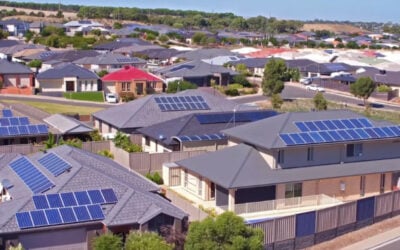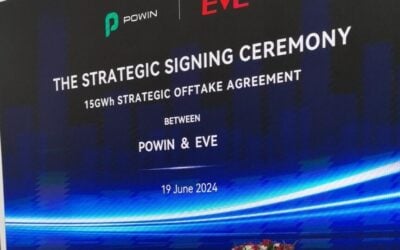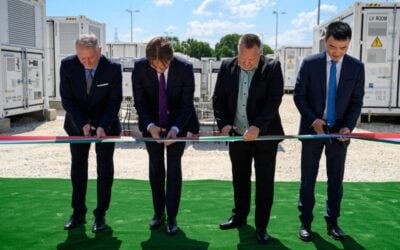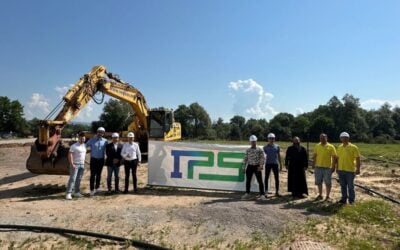After reports that it will build facilities to rival the capacity of Tesla’s ‘Gigafactory’, Chinese battery and EV-maker BYD (‘Build Your Dreams’) faces a similarly ambitious task to scale up demand, an analyst has told PV Tech Storage.
A recent Reuters report quoted a BYD spokesman in the US as having said the company will add as much as six gigawatt-hours production each year for the next three years. This would take the company up from its present production capacity of 10GWh to around 34GWh in 2020.
Enjoy 12 months of exclusive analysis
- Regular insight and analysis of the industry’s biggest developments
- In-depth interviews with the industry’s leading figures
- Annual digital subscription to the PV Tech Power journal
- Discounts on Solar Media’s portfolio of events, in-person and virtual
Tesla meanwhile, has started construction work on its Nevada facility, planned to have an output of 500,000 vehicle battery packs a year by 2020, equating to around 35GWh of cells, or 50GWh of battery packs. In addition to a partnership on battery production with Panasonic, Tesla has supply deals with residential solar leasing company SolarCity and has ramped up its own stationary storage division, advertising for more than 70 staff members on the company website.
When the Gigafactory was first announced, analyst Dean Frankel at Lux Research was quoted in press as saying that his firm did not expect Tesla to meet the half a million a year sales target, at least not through demand for EVs as forecasted by Lux. Frankel later expanded on this statement and other aspects of the Gigafactory announcement, in an interview with PV Tech Storage.
BYD is not limiting its production options to one factory as Tesla is, with Reuters claiming the Chinese company will also build a facility in Brazil and wants to target markets in the US and Latin America, particularly for its buses.
Lilia Xie, Dean Frankel’s colleague at Lux Research said these other markets would be important to BYD’s “very ambitious” plan, as it is unlikely the market for EVs in China would grow to soak up the full 34GWh capacity. Xie, who is currently looking at the market for EVs in China, said that 2014 was a “big year” for EVs in the country in which BYD held as much as a 39% share of the total new energy vehicle market.
BYD led the EV market in 2014, according to Lux Research. Image: wikimedia user: Navigator84.
According to Xie, the market for EVs and similar technologies has grown in China to the point where despite BYD’s big share and record sales, the company’s overall share of the market actually decreased last year on the back of increased competition from a number of makers including BAIC and Chery.
“BYD’s plan is definitely very ambitious. I wouldn’t say that it’s obvious that the growth of present demand will fill the demand that they’re anticipating in 2018 or 2020,” Xie said.
“We (Lux Research) predict that total yearly lithium ion battery demand in China in 2025 will be less than 35GWh for the vehicle market. That’s looking at light vehicles, passenger vehicles and buses and heavy vehicles.”
However, Xie said it was not as simple as trying to match domestic demand for EVs to BYD’s battery output. BYD, in which celebrity investor Warren Buffet holds a stake, also supplies a number of other makers and industries with its batteries and systems.
“I think one thing it’s important to consider when looking at BYD’s predicted supply versus the demand is that they also have a lot of other channels that they can divert their supply into.
“For example, China is also making a big push on residential and distributed solar and BYD has a solar division [which] can use up some of the excess capacity by putting the batteries into energy storage units for homes or businesses. So that’s one way similar to Tesla that they can divert excess capacity.
“Another thing that makes this projection a bit difficult is that when you look at buses and heavy vehicles, the energy storage usage is huge. BYD makes a lot of buses and most of them are EV buses.”
When Lux spoke to BYD in July 2014, Xie said, some of the Chinese company’s buses and heavy vehicles were using 365kWh battery packs, compared to their most popular consumer EV, the Qin, which uses a 13kWh battery pack, meaning “one bus is worth 20 of the passenger vehicles”.
As another point of recent reference, Xie mentioned Boston Power, a US-based battery company which made its own bold claims about battery production capacity – and about China.
“They are an American company that has two facilities in China and they’re building up to several GWh of production. I think their goal is 10GWh by 2018, but they’re targeting specifically the EV market in China.”
Xie said it was an interesting anecdotal comparison and if anything, said Boston Power would be taking even more of a risk than Tesla or BYD if it went ahead with its plans, not least of all because Boston Power seemed intent on hitting the EV market alone, without other channels in place.
“I think it’s very risky,” Xie said of Boston Power’s strategy.
“One, they’re not really a Chinese company but want to operate almost completely in China. Two, they have the relationships now but they don’t have any big orders for their batteries to go into vehicles. They have relationships with major original equipment manufacturers (OEMs) but there’s no major EV on sale today that’s using their batteries yet. Three more years (to 2018) is not very long when you look at automotive design cycles.”
PV Tech Storage attempted to contact BYD and the spokesman quoted by Reuters via email but did not receive a response ahead of publication.
There are an increasing number of competing EV makers in China, including Chery, pictured. Image: wikimedia user: Ilya Plekhanov.






